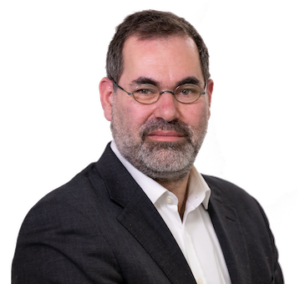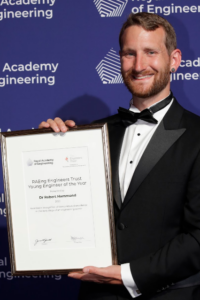People
All email addresses listed below end in the suffix ‘@st-andrews.ac.uk’.
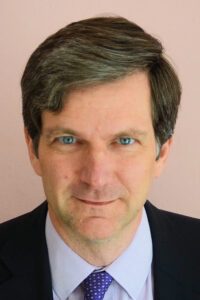 Prof Ifor Samuel
Prof Ifor Samuel
Organic Semiconductor Optoelectronics
Ifor studied for both his MA and PhD in Physics at Cambridge where he developed his fascination with conjugated polymers. After finishing his PhD he moved to Paris and worked with France Telecom for two years, investigating the non linear optical properties of organic materials. Then he returned to Cambridge for a year, received a Royal Society University Research Fellowship and took up a position at the University of Durham until August 2000 when he moved to St Andrews. In 2001 he started the Organic Semiconductor Centre to encourage collaboration between physicists and chemists in developing the next generation of organic semiconductors and the wider field of organic electronics.
Email: idws
![]() https://orcid.org/0000-0001-7821-7208
https://orcid.org/0000-0001-7821-7208
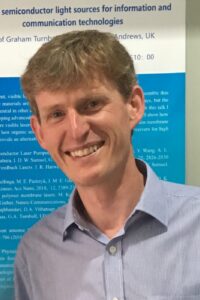 Prof Graham Turnbull
Prof Graham Turnbull
Organic Semiconductor Optoelectronics
Graham is a professor in the School of Physics and Astronomy at the University of St Andrews. He graduated with a first-class M.Sci. degree in physics in 1995 and a Ph.D. in 1999, both from the University of St Andrews. His doctoral research project on nonlinear optics was supported by a Carnegie Trust Scholarship. Graham’s work on organic semiconductors began as a postdoc at the University of Durham. From 2002 to 2007 he held an EPSRC Advanced Research Fellowship. He is a Senior Member of the IEEE and Fellow of the Institute of Physics. His current research interests focus on photonic applications of soft materials, including organic semiconductors, plastic lasers, chemical sensing, smart lighting technologies and nanophotonics.
Email: gat
![]() https://orcid.org/0000-0002-2132-7091
https://orcid.org/0000-0002-2132-7091
Prof Eli Zysman-Colman
Eli Zysman-Colman obtained his PhD from McGill University in 2003 under the supervision of Prof. David N. Harpp as an FCAR scholar, conducting research in physical organic sulfur chemistry. He then completed two postdoctoral fellowships, one in supramolecular chemistry with Prof. Jay Siegel at the Organic Chemistry Institute, University of Zurich as an FQRNT fellow and the other in inorganic materials chemistry with Prof. Stefan Bernhard at Princeton University as a PCCM fellow. He joined the department of chemistry at the Université de Sherbrooke in Quebec, Canada as an assistant professor in 2007. In 2013, he moved to the University of St. Andrews in St. Andrews, UK, where he is presently Professor of Optoelectronic Materials, Fellow of the Royal Society of Chemistry and a past holder of a Royal Society Leverhulme Trust Senior Research Fellowship. His research program focuses on the rational design of: (I) luminophores for energy-efficient visual displays and flat panel lighting based on organic light emitting diode (OLED) and light-emitting electrochemical cell (LEEC) device architectures; (II) sensing materials employed in electrochemiluminescence; and (III) photocatalyst developing for use in organic reactions.
Email: eli.zysman-colman
![]() https://orcid.org/0000-0001-7183-6022
https://orcid.org/0000-0001-7183-6022
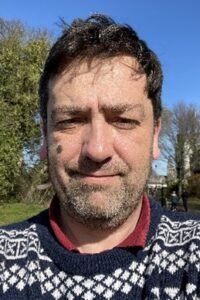 Dr Jean Charles Ribierre
Dr Jean Charles Ribierre
Organic Electronics and Photonics Group
Jean Charles has been appointed as a reader at the School of Physics and Astronomy of the University of St Andrews in January 2023. He obtained his PhD in 2002 from the University of Strasbourg in France, conducting research on the physics of photorefractive polymers under the supervision of Dr Alain Fort. After postdoctoral research experiences in organic optoelectronics at RIKEN in Japan and at the University of St Andrews, he joined as an assistant professor the department of Physics of Ewha Womans University in South Korea between 2010 and 2013. He was then appointed as an associate professor in the Center for Organic Photonics and Electronics Research (OPERA) of Prof Chihaya Adachi at Kyushu University, focusing his research activities on the development of high-efficiency near infrared TADF OLEDs and the realization of current injection organic laser diodes. He also has a strong experience in the translation of new technology with the creation of a startup company in Japan, KOALA Tech, of which he was the CEO between 2019 and 2022. His group at St Andrews will focus on the physics and the development of novel organic electronic technologies for energy and sustainability, which include the engineering of a novel metamaterial platform for organic optoelectronics.
Email: jr43
![]() https://orcid.org/0000-0001-7183-6022
https://orcid.org/0000-0001-7183-6022
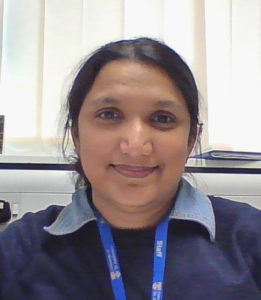
Dr Lethy Krishnan Jagadamma
Energy Harvesting Research Group
Dr Lethy Krishnan Jagadamma is a UKRI-Future Leaders Fellow & Reader in Physics/Principal Research Fellow and leads the Energy Harvesting Research Group at the School of Physics and Astronomy, University of St Andrews. While a Post-doctoral fellow at KAUST she expanded her research expertise to the field of solution-processed photovoltaics and contributed to the development of record-efficient organic and quantum dot solar cells. Then, In 2015 she returned to the UK to join as a Research Fellow at the Organic Semiconductor Centre at the University of St Andrews, UK (Professor Ifor Samuel as supervisor). In 2017, she was awarded the Marie-Curie Individual Fellowship, to focus her research on the ‘Time-resolved photovoltaic properties of hybrid perovskite semiconductors.’ In March 2020, she was awarded the prestigious UKRI-Future Leaders Fellowship to build her research team.
Currently, her research focus is on combining material-focused innovation with that of the emerging huge technologies such as the Internet of Things (IoT) and Wearables to positively contribute to achieving the big target of ‘Energy Sustainability’. Her research team develops scalable and efficient ambient energy harvesters to self-power disruptive technologies such as IoT so that their reliance on batteries can be reduced. For ‘Sustainable Energy Harvesting’, specifically, her team investigates indoor photovoltaics (IPVs), device physics of indoor PV, ferroelectric properties, and piezoelectric properties of solution-processable semiconductors.
Email: lkj2
![]() https://orcid.org/0000-0002-4339-2484
https://orcid.org/0000-0002-4339-2484
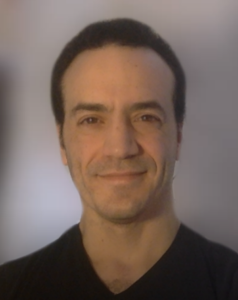
Prof Andrea Di Falco
Andrea leads the Synthetic Optics group in the School of Physics and Astronomy, in St. Andrews. His main research focus is the development of versatile multi-material platforms for the control of light behaviour at the nanoscale in time and space, for applications including biophotonics, imaging, augmented reality, and optical neural networks. With his EPSRC career acceleration fellowship, in 2010 Andrea introduced the concept of flexible metasurfaces at optical frequencies. In 2019 he was awarded an ERC consolidator to introduce the metamaterials technology in microfluidics environments for biophotonics applications, capitalizing on the work supported by research grants from EPSRC, Wellcome Trust, DSTL(DASA), and the Royal Society. Andrea Di Falco is a member of the leadership team of the UK Metamaterials Network and editor-in-chief of Photonics and Nanostructures: Fundamentals and Applications, edited by Elsevier.
Email: adf10
![]() https://orcid.org/0000-0002-7338-8785
https://orcid.org/0000-0002-7338-8785
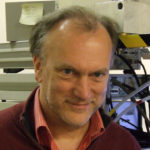
Prof Graham Smith
Prof Graham Smith received his BSc in Theoretical Physics from the University of York in 1984, MSc in Lasers and Optoelectronics in 1985, and PhD in mm-wave Physics from the University of St Andrews in 1990. He was appointed as a lecturer in 2000, and a professor in 2018, in the School of Physics and Astronomy at St Andrews. He currently heads the mm-wave and ESR group at St Andrews. He has broad interest in all aspects of mm-wave technology, with specific interests in developing advanced mm-wave electron spin resonance (ESR) instrumentation, and related application programs. He previously managed the UK High field EPR facility, and has served as Chair of the RSC EPR Group and European Federation of EPR Groups and was awarded the International EPR Society Silver Medal for Instrumentation in 2011. He was the first Director of the Magnetic Resonance Centre at St Andrews, and is a member of StAnD which is collaboration between Physics, Biology and Chemistry EPR groups from the Universities of St Andrews and Dundee.
Email: gms
![]() https://orcid.org/0000-0001-6578-7412
https://orcid.org/0000-0001-6578-7412
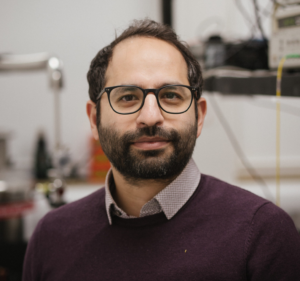 Dr Hamid Ohadi
Dr Hamid Ohadi
Hamid Ohadi is a lecturer at the University of St. Andrews. He completed his BSc in physics in 2003 at Sharif University in Tehran, Iran, where his passion for quantum science was ignited. He then pursued a PhD at Imperial College London in 2008, focusing on trapping and laser cooling of calcium ions in a Penning trap. Subsequently, he embarked on a postdoctoral research position at the University of Southampton (2009), where his work centered on the trapping and cooling of rubidium atoms. He continued his academic journey with a postdoctoral position at the University of Cambridge, until taking up his current lectureship role at the University of St. Andrews in 2018. His research is dedicated to the fascinating world of strong light-matter interactions, particularly involving Rydberg excitons, exciton-polaritons, and two-dimensional materials.
Email: ho35
![]() https://orcid.org/0000-0001-6418-111X
https://orcid.org/0000-0001-6418-111X
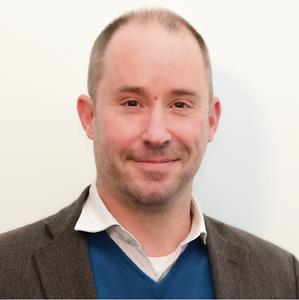
Dr Renald Schaub
Renald graduated in 1996 from the Dept. of Physics of the University of Lausanne, Switzerland. He then carried out PhD studies at the Dept. of Physics of the Swiss Federal Institute of Technology in Lausanne (EPFL) followed by postdoctoral research at the Interdisciplinary Nanoscience Centre of the University of Aarhus in the group of Professor F. Besenbacher. Since 2006 he has been at the School of Chemistry in St Andrews, firstly as an EaStCHEM Hirst Fellow and then since 2011 as a Lecturer. His expertise lies in the application of high-resolution scanning probe microscopy and spectroscopy (SPM and STS) to study fundamental processes related to the nano-scale design and characterisation of functional materials. His contribution to the field of SPM has been significant, with several publications in highly-regarded scientific journals (Science, Nature Communications, ACS Nano, Nano Letters, Physical Review Letters).
Email: rs51
![]() https://orcid.org/0000-0002-1712-3336
https://orcid.org/0000-0002-1712-3336
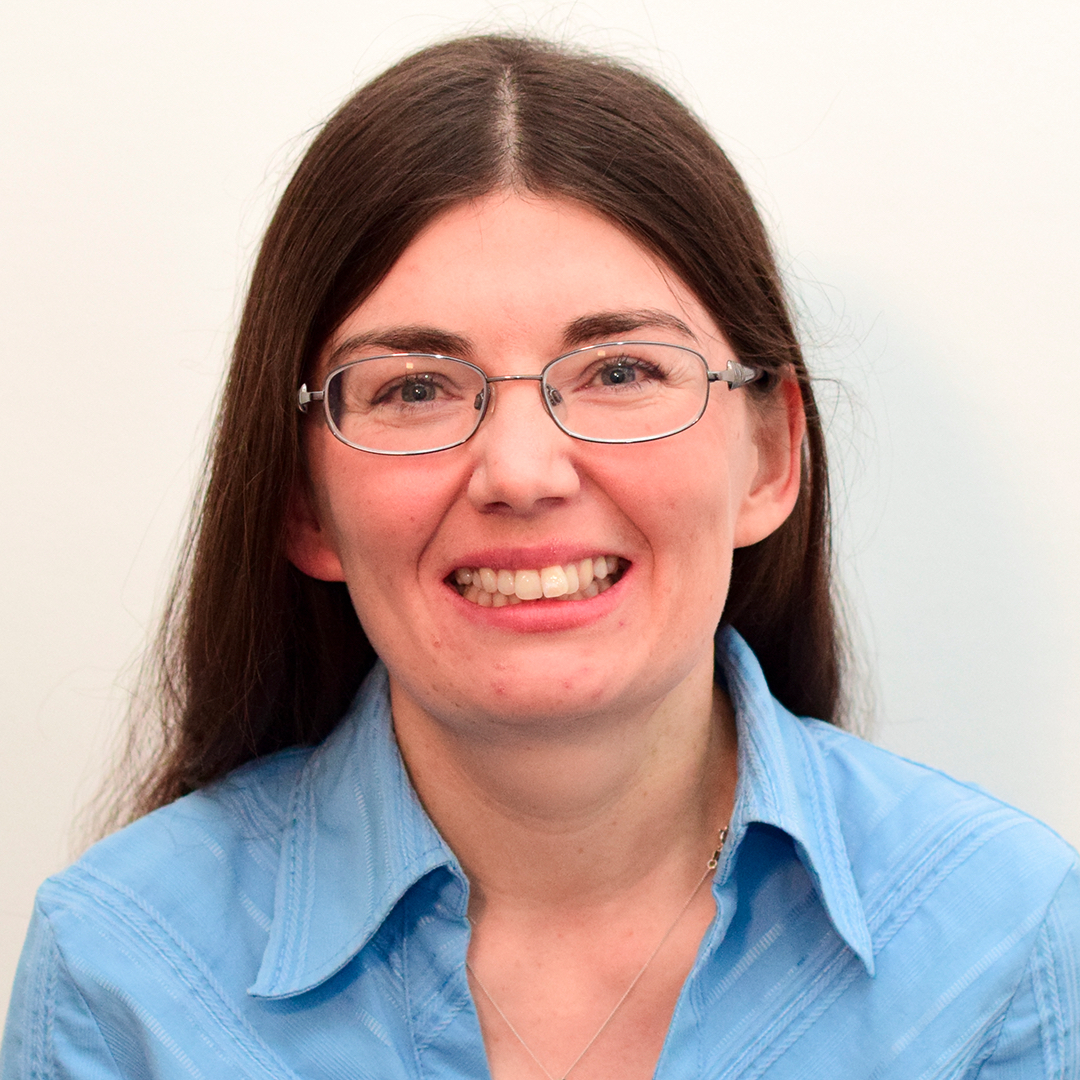
Dr Julia Payne
Dr Payne was awarded her MChem in 2007 by the University of Warwick and her PhD in 2011 by Durham University (under the supervision of Prof. Ivana Evans). Following this, she worked as a PDRA in the groups of Prof. Ivana Evans (Durham University, 2011-2012), Prof. Matthew Rosseinsky (University of Liverpool, 2012-2014) and Prof. John Irvine (University of St Andrews, 2014-2018). In January 2019 Dr Payne took up a position as an independent Research Fellow in Energy Materials in the School of Chemistry at the University of St Andrews, where she is now a Lecturer in Inorganic Chemistry. Dr Payne’s research spans a broad range of energy materials and she is particularly interested in using in-situ and operando techniques to link structure with properties.
Reducing the world’s reliance on fossil fuels is one of the greatest challenges facing society today. In order to meet future energy demands, new materials are required for energy storage and conversion. Our research spans a wide range of energy materials and we are currently interested in the synthesis of new materials for batteries and photovoltaics. Work in our group focuses on the synthesis, characterisation and properties of energy materials. We are particularly interested in understanding how the structure of materials changes during device operation (e.g. charging/discharging a battery). To do this, we regularly carry out experiments at the UK synchrotron (Diamond Light Source) or the UK neutron facility (ISIS Neutron and Muon Source) in Oxfordshire. We use a variety of techniques to probe energy materials, including powder diffraction (X-ray and neutron), single crystal diffraction and X-ray Absorption spectroscopy.
Email: jlp8
![]() https://orcid.org/0000-0003-3324-6018
https://orcid.org/0000-0003-3324-6018
Dr Euan Kay
Euan is a synthetic chemist with interests in supramolecular chemistry and nanochemistry. He received both his MChem (1997) and Ph.D. (2002) degrees from the University of Edinburgh, where he worked with Prof. David Leigh on controlling molecular-level motion using ‘interlocked’ molecules such as catenanes and rotaxanes. After a period of postdoctoral work in Edinburgh, Euan joined the laboratory of Prof. Moungi Bawendi at the Massachusetts Institute of Technology as an 1851 Research Fellow. There, he worked on combining molecular machines with semiconductor quantum dots to develop fluorescent sensors. In 2011, Euan was awarded a Royal Society of Edinburgh / Scottish Government Fellowship and moved to the School of Chemistry at St. Andrews. His research group work focus on combining design concepts from supramolecular chemistry and nanochemistry to create nanomaterials that display dynamic and responsive structures and properties.
Email: ek28
![]() https://orcid.org/0000-0001-8177-6393
https://orcid.org/0000-0001-8177-6393
Dr Robert Hammond
Dr Hammond is an Accredited Biomedical Scientist with a particular interest in microbiology. Dr Hammond was educated in Northern England where he grew up and attended the universities of Strathclyde and Glasgow to attain his Undergraduate and Masters Degrees. During this time Dr Hammond discovered his deep fascination with microorganisms generally and those that cause disease in particular. To further his ambitions and learning Dr Hammond applied to and was accepted by, the University of St Andrews Medical School as a PhD student in 2012.
In 2016 Dr Hammond graduated but had begun postdoctoral training prior to this. Also in 2016 Dr Hammond and colleagues won a Longitude Prize Discovery Award, and in 2018 the Scottish Life Science Innovation of the Year Award both for the novel SLIC technology. In the same year Dr Hammond and colleagues spun out their start-up company and Dr Hammond began work as an Industrial Research Fellow at the University.
In 2022 Dr Hammond began a new role as a Lecturer in the Division of Infection and Global Health but maintains an active research portfolio with PhD students from across disciplines and continents.
Email: rjhh
![]() https://orcid.org/0000-0003-3664-3641
https://orcid.org/0000-0003-3664-3641
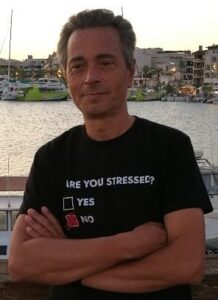 Prof Carlos Penedo
Prof Carlos Penedo
Labratory for Biophysics and Biomolecular Dynamics
Carlos graduated in Chemistry and studied for a PhD in time-resolved spectroscopy at the University of Santiago de Compostela (Spain). Then he joined the group of Prof John Kelly at Trinity College Dublin on the topic of metal complexes photophysics and DNA photodamage. After working for Edinburgh Instruments Ltd (Scotland) for two years, he took a three-year postdoc in the group of Prof David Lilley at the University of Dundee to develop single-molecule methods for RNA imaging. In 2007, he has awarded a Scottish University Physics Alliance (SUPA) fellowship at the School of Physics and Astronomy, and since 2010, he is a joined appointment with the School of Biology. His current research interests focus on single-molecule fluorescence microscopy and force-based methods to investigate the structure and dynamics of biomolecules, the mechanics and photophysics of conjugated polymers, and the development of fluorescent probes and sensors. Since 2019, he is the Director of the Centre of Biophotonics.
Email: jcp10
![]() https://orcid.org/0000-0002-5807-5385
https://orcid.org/0000-0002-5807-5385
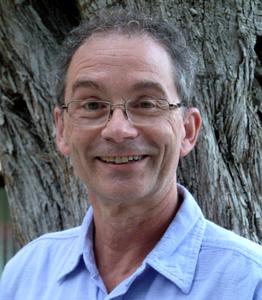
Prof Manfred Buck
Manfred is a professor in the School of Chemistry at the University of St Andrews. After his diploma in chemistry (1984) and a PhD in physical chemistry (1988) from the University of Heidelberg he joined IBM at the Almaden research labs in San Jose, California as a research fellow to work on chemical vapour deposition of diamond thin films. This work also triggered his interest in nonlinear laser spectroscopy as a tool for the analysis of interfaces, which became a pillar of his research after his return to Heidelberg (1989) and also the topic of his Habilitation (1994). Molecular assemblies at the liquid/solid interface developed into another focus of his research during that time which, since his move to St Andrews in 2000, has evolved along different directions comprising self-assembled monolayers and supramolecular assemblies, nano-electrodeposition, and more recently, carbon nanomembranes.
Email: mb45
![]() https://orcid.org/0000-0003-1225-7607
https://orcid.org/0000-0003-1225-7607

